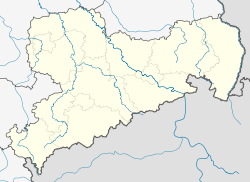Our website is made possible by displaying online advertisements to our visitors.
Please consider supporting us by disabling your ad blocker.
Plauen
You can help expand this article with text translated from the corresponding article in German. (January 2022) Click [show] for important translation instructions.
|
Plauen | |
|---|---|
View over the city centre Old and new city hall Astronomical clock of the city hall St John's Church Old market square | |
Location of Plauen within Vogtlandkreis district  | |
| Coordinates: 50°29′N 12°07′E / 50.483°N 12.117°E | |
| Country | Germany |
| State | Saxony |
| District | Vogtlandkreis |
| Subdivisions | 5 city boroughs with 38 parts |
| Government | |
| • Lord mayor (2021–28) | Steffen Zenner[1] (CDU) |
| Area | |
• Total | 102.11 km2 (39.42 sq mi) |
| Elevation | 412 m (1,352 ft) |
| Population (2022-12-31)[2] | |
• Total | 64,763 |
| • Density | 630/km2 (1,600/sq mi) |
| Time zone | UTC+01:00 (CET) |
| • Summer (DST) | UTC+02:00 (CEST) |
| Postal codes | 08523;-5;-7;-9 |
| Dialling codes | 03741 |
| Vehicle registration | V, AE, OVL, PL, RC |
| Website | www |
Plauen (German pronunciation: [ˈplaʊən];[3][4] Upper Sorbian: Pławno; Czech: Plavno) is a town in Saxony, Germany with a population of around 65,000. It is Saxony's 5th most populated city after Leipzig, Dresden, Chemnitz and Zwickau, the second-largest city of the Vogtland after Gera, as well as the largest city in the Saxon Vogtland region (Sächsisches Vogtland).
The city lies on the upper reaches of the White Elster River, a tributary of the Saale, in the Central Vogtlandian Hill Country. Plauen is the southwesternmost city of a string of cities sitting in the densely populated foreland of the Elster and Ore Mountains, stretching from Plauen in the southwest via Zwickau, Chemnitz and Freiberg to Dresden in the northeast. It is the county seat of the Vogtland District. Plauen directly borders Greiz in Thuringia to the north, and it is also situated near the Saxon border with Bavaria (Franconia) and the Czech Republic (Bohemia).
Plauen and the surrounding Saxon Vogtland are known as the historic center of the German embroidery and lace industry, and the products of the region are protected under the label Plauener Spitze ("Plauen Lace"). The Elster Viaduct (Elstertalbrücke), spanning the valley of the White Elster between Plauen and Pöhl, is the second-largest bridge built out of bricks in the world, after the Göltzsch Viaduct.
Despite its location in Saxony the regional Vogtlandian dialect spoken in Plauen is a variety of East Franconian (with Saxon influences) related to the dialects of neighbouring Franconia in Bavaria. The name of the city as well as the names of many of its neighborhoods and boroughs are of Slavic origin.
- ^ Gewählte Bürgermeisterinnen und Bürgermeister im Freistaat Sachsen, Stand: 17. Juli 2022, Statistisches Landesamt des Freistaates Sachsen.
- ^ "Einwohnerzahlen nach Gemeinden als Excel-Arbeitsmappe" (XLS) (in German). Statistisches Landesamt des Freistaates Sachsen. 2024.
- ^ Krech, Eva-Maria; Stock, Eberhard; Hirschfeld, Ursula; Anders, Lutz Christian (2009). Deutsches Aussprachewörterbuch (in German). Berlin: Walter de Gruyter. p. 828. ISBN 978-3-11-018202-6.
- ^ Mangold, Max (2005). Das Aussprachewörterbuch (in German) (6th ed.). Mannheim: Dudenverlag. p. 635. ISBN 9783411040667.
Previous Page Next Page











